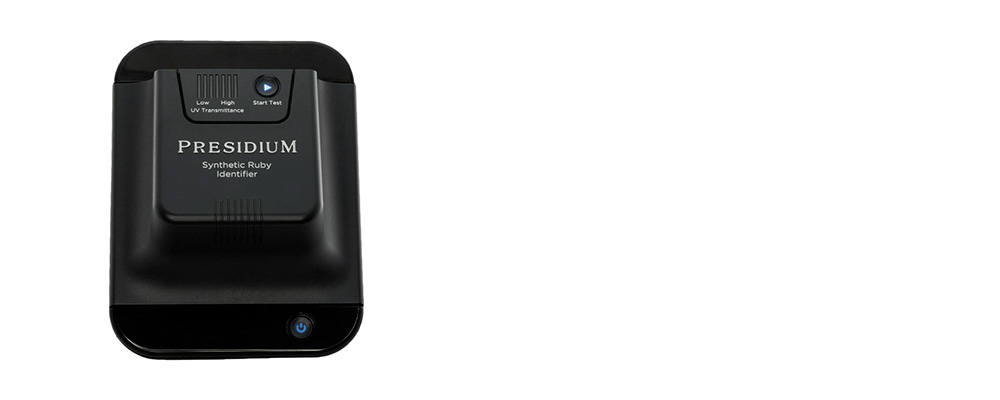In the lab and marketplace alike, gemologists and gem traders seek to separate natural ruby from synthetic with training and gemological equipment. But what if there was an easier, faster method?
Presidium, in collaboration with The Gem and Jewelry Institute of Thailand (GIT), recently released a Synthetic Ruby Identifier (SRI) designed to separate natural ruby from synthetic flame fusion ruby. Bangkok’s Lotus Gemology laboratory was given the opportunity to try out this new instrument to evaluate its utility and accuracy.
About the Instrument
Presidium’s SRI is a handheld device that measures the UV-Vis light transmission of the stones tested. Presidium and GIT found that between 250-275nm, natural and synthetic (flame fusion) rubies tend to display different transmittance spectra, with the synthetic stones transmitting more UV than natural stones (see Figure 2). Thus, they chose 260nm as the operating wavelength for the SRI’s LED light source. Light passes through the stone, which rests on a platform, and is transmitted to the photo-detector.
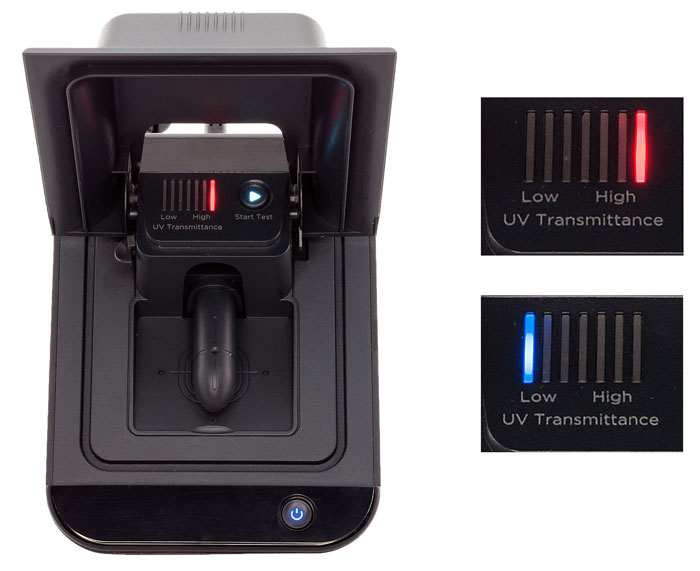 Figure 1. Top left: The Synthetic Ruby Identifier (SRI) when open. The finger-like projection is the ring holder and LED light source; the detector is on the platform below. Top right: A high transmittance reading, indicating a synthetic stone. Bottom right: A low transmittance reading, indicating a natural stone. Photos: E. Billie Hughes
Figure 1. Top left: The Synthetic Ruby Identifier (SRI) when open. The finger-like projection is the ring holder and LED light source; the detector is on the platform below. Top right: A high transmittance reading, indicating a synthetic stone. Bottom right: A low transmittance reading, indicating a natural stone. Photos: E. Billie Hughes
|
Limitations & User Caution*
*From the Presidium Synthetic Ruby Identifier Technical Pamphlet |
Utility
The SRI is designed to be quick, easy to use, and portable. This author did find it easy to learn to use. The procedure is as follows: place the stone on the platform over the photo-detector, which has markings indicating proper placement, close the lid and press the “start test” button to test the stone. Within seconds the indicator light will come on, separating natural from synthetic ruby.
The instrument has seven light indicator bars. If the measurement is within the range of natural ruby (displaying lower transmittance), one of the first four bars will light up blue. If within the range of flame-fusion synthetic ruby (displaying higher transmittance), one of the final three bars will light up red (see Figure 1).
However, it can be tricky placing the stone over the photo-detector. A specimen must be at least 3 x 3 mm in all directions to completely cover the detector below it. The combination light source and ring guide protrude over the detector and make it difficult to see if the stone precisely positioned (see Figure 1). If the stone is slightly askew, leaving as little as 1mm or less of the detector exposed, the accuracy may vary wildly. For an instrument billed as quick and easy to use, this required precision slows one down considerably and is therefore a drawback.
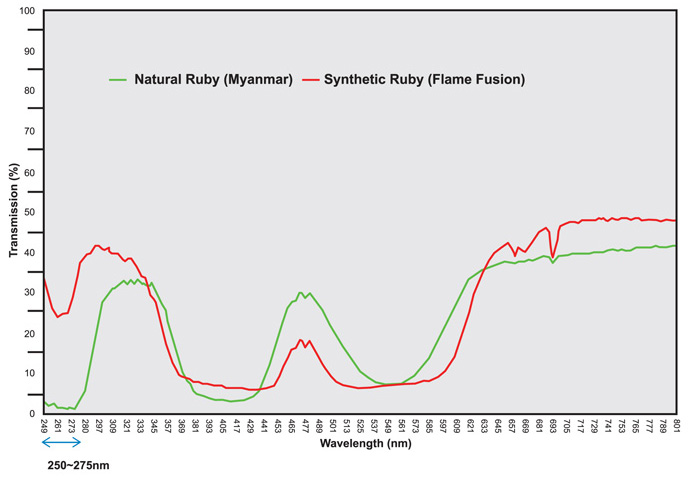 Figure 2. Typical synthetic and natural ruby transmittance spectra taken using a Perkin Elmer Model Lambda 950 UV-Vis spectrophotometer. Note the difference between the spectra in the 250–275nm range. Image courtesy of Presidium.
Figure 2. Typical synthetic and natural ruby transmittance spectra taken using a Perkin Elmer Model Lambda 950 UV-Vis spectrophotometer. Note the difference between the spectra in the 250–275nm range. Image courtesy of Presidium.
Presidium recommends testing stones at more than one orientation. This can yield different readings at different orientations, leaving the user wondering which result to trust. (Presidium recommends the user take the result that is recorded most consistently through the different orientations.)
With the instrument, Presidium provides a carrying case, with compartments for batteries and cords, for ease of transport. It is relatively portable, weighing significantly less than a typical laptop, and fits easily enough into a bag or backpack, but its size cannot compare to the pocketable convenience of a loupe.
The SRI runs on either four AAA batteries or a USB connection.
Accuracy
Following the directions provided by Presidium, the SRI was used to test rubies both in the Lotus Gemology lab and in the marketplace. This included both known rubies, both natural and synthetic, numbering over 100 stones in total in a variety of sizes and colors, from pinks to deeper reds. While most stones tested were within the limitations acknowledged by Presidium (see sidebar), we also tested some stones outside of these limitations.
Many of these limitations are so restrictive that it detracts from the utility of the SRI for practical application. Of the stones within the given limitations, most were accurate, particularly in lighter pinks, but several tested inaccurately.
For example, in a parcel of six synthetic Verneuil flame-fusion synthetics, one came out “natural,” with the indicator light turning blue in the lowest UV transmittance region. When the stone was rotated and re-tested, it produced a variety of results, from both the lowest (natural) UV transmittance and the highest (synthetic) UV transmittance detected, with some results falling in between. This author suspects the issue is alignment, for - as cautioned above - if even a sliver of the Photo-detector remains uncovered, the instrument will produce an inaccurate reading (note that this stone was within the range of sizes of stones that Presidium recommends for testing). Even if user error is to blame, the precision with which a stone must be positioned on the detector makes the SRI awkward to use.
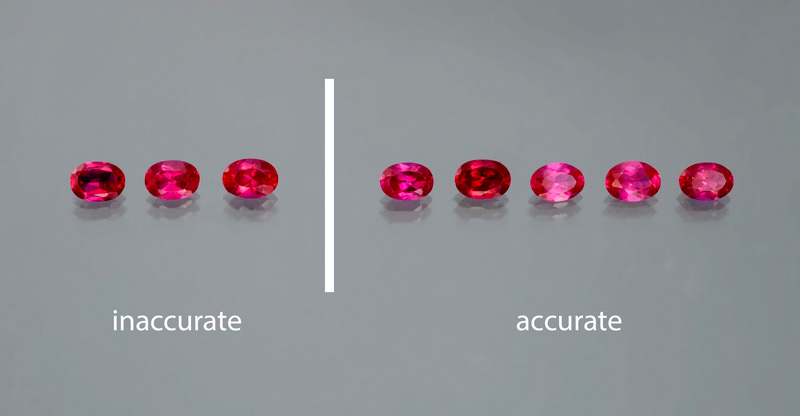 Figure 3. Flame fusion synthetics. Stones that are borderline between pink and red can pose problems for the SRI. Although these stones are similar in color, some tested accurately and some inaccurately, calling into question whether the instrument should be used at all for stones of this color range. Photo: E. Billie Hughes
Figure 3. Flame fusion synthetics. Stones that are borderline between pink and red can pose problems for the SRI. Although these stones are similar in color, some tested accurately and some inaccurately, calling into question whether the instrument should be used at all for stones of this color range. Photo: E. Billie Hughes
In order to see how the SRI would fare in the field, it was taken to Bangkok’s Wat Koh neighborhood, which is known for selling synthetic gems. The instrument was generally accurate with pastel pink and even darker pink and fuchsia stones, but had problems once stones got into the true reds. However, one synthetic pink stone tested inaccurately. Again, this stone was within the size range recommended by Presidium.
Also, two red synthetic rubies around 6 x 4 mm (about 1 ct. each) gave inconsistent results when rotated.
The practical problems posed by the stated limitations of the SRI were perhaps best demonstrated when faced with a parcel of red 10 x 8 mm synthetics of about 4 ct. each. In a parcel like this, although stones are of similar size, some stones are above 6mm while others are under this limit. Such a parcel becomes un-testable unless one first filters out the stones by individually measuring each stone, a time-consuming procedure when faced with large parcels.
Furthermore, in this parcel even the stones measuring under 6mm in thickness tested inconsistently when rotated. This reinforces how limited the range of stones that can be tested with the instrument is.
For stones outside of the size range recommended by Presidium, this author did find the results to be inaccurate, as expected. Chatham, Ramaura (flux), and hydrothermal synthetics also produced inaccurate results. Thus users should be careful to stay within the limits suggested in the user guide. However, for some users this will present practical problems. Parcels where some stones fall within the range and some do not must either be pre-sorted before testing or cannot be tested reliably. They must be sorted not only for size requirements, but also for non-flame fusion synthetics.
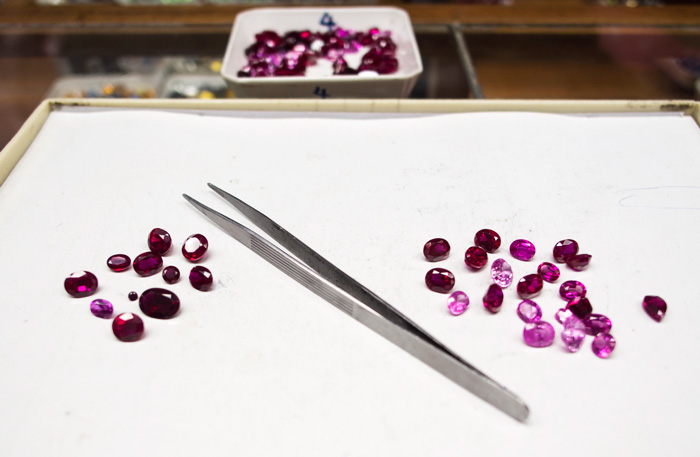 Figure 4. The stones above were from a mixed parcel of synthetic ruby (in the tray at the back). The stones to the right of the tweezers tested accurately, while the stones to the left did not. One can see that the stones that tested accurately tend to be of lighter to medium color, while the stones that had problems were darker and include those of very small size. Photo: E. Billie Hughes
Figure 4. The stones above were from a mixed parcel of synthetic ruby (in the tray at the back). The stones to the right of the tweezers tested accurately, while the stones to the left did not. One can see that the stones that tested accurately tend to be of lighter to medium color, while the stones that had problems were darker and include those of very small size. Photo: E. Billie Hughes
Value
At a suggested retail price of $2,199 USD, the Synthetic Ruby Identifier requires serious consideration of benefits versus drawbacks.
If one tests stones within the limits recommended by Presidium, the SRI does for the most part identify stones correctly, albeit with some errors. Generally, it performed well on pink sapphire, but stones in the reddish range were often misidentified.
The main drawback is that the instrument’s limitations are extremely restrictive.
This is especially true for large parcels. As far as size/carat limitations, parcels of stones that may contain just some stones outside of the dimension limits become untestable unless one first sorts through by size, ruling out larger stones as well as non-flame fusion synthetics.
On the other hand, smaller stones (over 3 x 3 mm) are more difficult to correctly align over the photo-detector, giving inaccurate results.
While Presidium acknowledges that color can also be an issue with deeper reds testing inaccurately, problems were found even testing rubies that are red or pinkish-red (see Figure 3). The instrument is much more accurate when measuring pink sapphire, and may be useful in dealing with large volumes of these lighter stones.
-0019.jpg) Figure 5. The Presidium Synthetic Ruby Identifier in action. This author took the SRI for a field test in the Wat Koh, a Bangkok neighborhood where dealers specialize in imitation and synthetic gemstones.
Figure 5. The Presidium Synthetic Ruby Identifier in action. This author took the SRI for a field test in the Wat Koh, a Bangkok neighborhood where dealers specialize in imitation and synthetic gemstones.
Photo: E. Billie Hughes
With these limitations it is difficult to justify spending $2200 on the Synthetic Ruby Identifier when one can obtain a microscope for the same price.
Understandably, it is unlikely that lab gemologists are the target market for such an instrument. Jewelers and other members of the trade would more likely benefit. In fact, when testing the SRI in the field, several curious dealers and their customers inquired about the instrument. Certainly there is a market for a quick, easy test for synthetic ruby. For users that deal in large volumes of pink sapphire in size ranges recommended for the SRI, it could be a useful tool.
This author would recommend that prospective buyers carefully consider the limitations of the instrument versus their specific needs and abilities before purchasing.
Although the idea of a simple machine to test for synthetic ruby is an attractive one, at this price, this author will stick to her microscope.

References
- Presidium Synthetic Ruby Identifier Technical Pamphlet. Presidium Instruments Pte Ltd., 2014. Print.
- Sim, Hwa San, et al. “Handheld Synthetic Ruby Screener Based on UV-Vis Light Absorption.” 2012: pp.1–6.
- Sim, Hwa San, et al. “Handheld Synthetic Ruby Identifier (SRI) Based on UV-Vis Light Absorption.” Power Point presentation. Personal communication.
Notes
The author would like to thank Presidium, Elise Skalwold, Nicha Manorotkul, Ajmal Gems Impex, Aziz Import and Export, Crown Gems, and Rahamat Gems for their assistance. This article was first published in InColor magazine (Summer 2014, Issue 26, pp. 18–23).
About the Author
E. Billie Hughes holds a B.A. degree from UCLA and is a Fellow of the Gemmological Association of Great Britain (F.G.A.). An avid traveler, accomplished photographer, and a published author, she is a gemologist at Bangkok’s Lotus Gemology laboratory.

